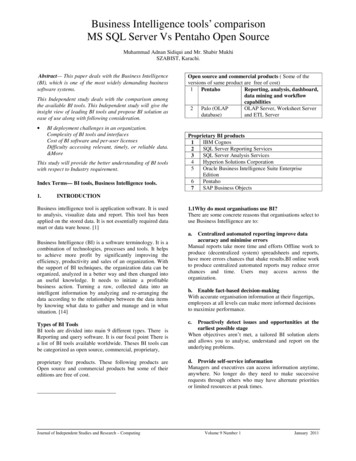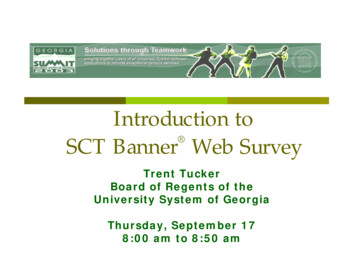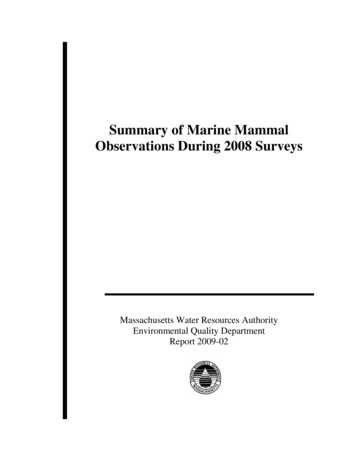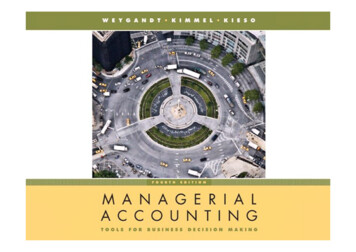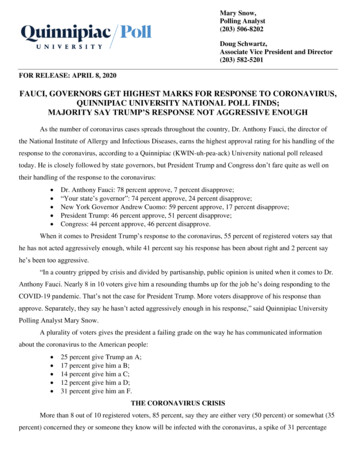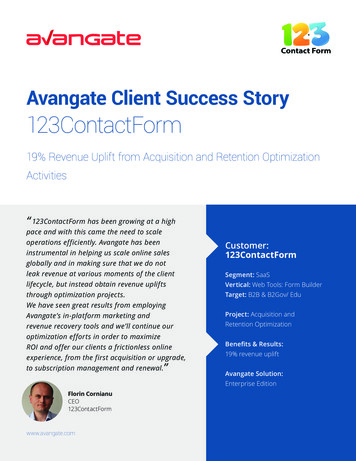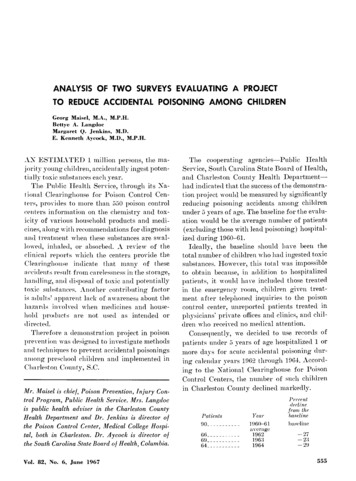
Transcription
ANALYSIS OF TWO SURVEYS EVALUATING A PROJECTTO REDUCE ACCIDENTAL POISONING AMONG CHILDRENGeorg Maisel, M.A., M.P.H.Bettye A. LangdocMargaret Q. Jenkins, M.D.E. Kenneth Aycock, M.D., M.P.H.A-VN ESTIMAI TED 1 million persoiis, the majority youngo clildlreni, accidenitally ingest potentially toxic substaiices eaclh year.The Public He(alth Service, tlrough its Nationial Clearinighlouse for Poison Control Centers, prov-ides to more thaii 550 poison controlcenters informuation on the clhemistry and toxicity of various lhousehold products and medicines, along witlh recommendations for diagnosisand treatmnent wlheni tlhese substances are swvallowed, inhlaled, or absorbed. A reviewv of theclinical reports wlich the centers provide theClearinghouse indicate that man-y of theseaccidenits resuilt from carelessness in the storace,handling, a1nd(l disposal of toxic and potentiallytoxic substances. Another contributinc factoris adults' apparenit lack of awareness abouit thelhazards involved whlen medicines and houselhold prodcucts ar e niot uised as intended ordirected.Tlherefore a demonstration project in poisonpreventioni was desigyned to investigate methodsaind teclhniques to prevent accidlental poisoningsamllonlg preschlool clhildren and implemented inCh1arleston1 Coiiiuty, S.C.Mr. Maisel is chief, Poison Prevention, Injury Control Program, Public Health Service. Mrs. Langdocis public health adviser in the Charleston CountyHealth Department and Dr. Jenkins is director ofthe Poison Control Center, Medical College Hospital, both in Charleston. Dr. Aycock is director ofthe South Carolina State Board of Health, Columbia.Vol. 82, No. 6, June 1967The cooperating agvencies-Public HealthService, Soutlh Carolina State Board of Health,and Clharleston County Health Departmiienthad indicated that the success of the deemonstration project would be measured by significantlyreducing poisoning accidents amlong childrenunder a years of ag,e. The baseline for the evaluation would be the average nuimber of patients(excluding those with lead poisoning) hospitalized during 1960-61.Ideally, the baseline should have been thetotal number of children who had ingested toxicsubstances. However, this total was impossibleto obtain because, in addition to hospitalizedpatients, it wouldIhave included those treatedin the emergency room, children given treatment after teleplhoned inquiries to the poisoncontrol center, unreported patients treated inphysicians private offices and clinics, ancd children wlho received no medical attention.Coonsequiently, we decided to use records ofpatients under 5 years of age hospitalized 1 ormore days for acute accidental poisoning, during calendar years 1962 through 1964. According to the National Clearinglhouse for PoisonControl Centers, the numnber of suclh childrenin Charleston County declined erage196219631964(leclinefrom thebaselinebaseline-27-23-29555
The purpose of this demonstration was to testthe hypothesis that a mass, intensive, educational campaign in a specific geographic areaover a given period of time can result in reducing accidental poisonings among children.Communications TechniquesAll the communications techniques traditionally used in other motivational programs wereused. Methods of communication included programs presented to organized groups (parentteacher associations and civic clubs); radioand television spot announcements, panel discussions, and interviews; and human intereststories in the press, along with public service and commercially sponsored messages.For radio spot announcements, the PublicHealth Service produced an electrically transcribed series of messages on poison prevention.Ten messages from 10 to 60 seconds long repeated essentially the same information usedon television and in newspapers.Do you know your home is full of potential poisons?Do you know your baby could find them and swallowthem?Do you know a half million babies do each year?We in the Public Health Service know-but there'svery little we can do about it without your help.Put poisonous household products like medicine, draincleaners, insect spray, sedatives, and kerosene outof your child's reach.For your child's sake, lock them up . . . today.Tomorrow might be too late.Other approaches included the use of posters,window streamers, and banners in grocerystores and pharmacies, counter cards in clinicand physicians' waiting rooms, bus cards and-exhibits or displays in public buildings.Use was made of the group discussion technique on the thesis that talking about a particular problem in a group situation would aidin its solution. We felt that neighbors who seeeach other frequently and informally may exertan important influence over one another. Usinga study by Wehrle and associates (1), whichsuggested a repetitive pattern of ingestions ofpotentially toxic substances among childrenwith a history of such ingestions, these discussions were developed among residents in neighborhoods with high incidence of accidentalingestions. Groups, usually limited to 12556women, gathered in a home or some othersuitable, convenient meeting place.Because these meetings were held in high-incidence areas, the group generally includedwomen who had had experience with accidentalingestions in their homes, and frequently theyrelated in detail their personal experiences.Such experiences enabled the women to identifywith the problem.One method developed in the project areaand now being used elsewhere is directed to thechildren and only indirectly to their parents. Aguide for teaching poison prevention in kindergarten was developed and subsequently expanded to include the primary grades (2).Through a series of learning experiences,youngsters are taught from kindergartenthrough third grade about the hazards of theirenvironment and how to cope with them. Theseexperiences include class interviews on differentdays with one child's mother, the school nurse,the school physician, a pediatrician, a pharmacist, a grocer, the health officer, or the sanitarian. Excursions were made to the grocerystore and the pharmacy. Children participatedin games, songs, and plays, all geared to ".asking first."Thus, youngsters, at this formative stage oftheir development, are taught proper habits forself-protection and the protection of youngerbrothers and sisters. At the same time, becausechildren in this age group repeat rather completely at home what they have learned inschool, parents are influenced to be aware ofthe problem and provide a safe environmentfor the family.Scope of the StudyThis paper does not discuss the project in detail; essentially, it is a comparative analysisof two surveys. The first, in 1962, took placeonly 6 months after the project was inauguratedand before all of the plans were in effect. Thesecond, in 1965, was conducted 6 months afterthe project's completion. In a sense the surveysare an evaluation of the methods and techniques employed. Moreover, the findings fromthis survey should remind community workersthat educational programs-no matter how wellprojected-are only as effective as their level ofPublic Health Reports
receipt. This axiom is demonstrated in the discussion of the parents' awareness of their children's mobility and ingenuity relating topotential poisoning hazards.The same questionnaire was used in both surveys, although the second sample was larger.In 1965, 1,129 interviews were conducted incontrast to 604 in 1962. Only 96 (8.5 percent)of the 1,129 respondents indicated they had beeninterviewed previously.Respondents' Sources of InformationIn 1962, 82.3 percent of the parents said theyhad seen or heard something about the dangerof children accidentally eating or swallowingthings like aspirin, kerosene, lye, or otherhousehold products; in 1965, this percentagewas 88.4 percent (table 1).The increase of nearly 100 percent of thoseindicating radio as their source for poison prevention information may reflect the use of theelectrical transcriptions. The transcriptionswere played very frequently by Charleston'sradio stations.The increased percentage of parents who saidschools were their source of information in 1965probably reflects the later emphasis on childrenin kindergarten and the primary grades as onemedium for reaching parents. The increase inthose mentioning group meetings also may reflect intensified efforts in this approach.Lack of information from the public healthnurse can be explained partly by the little contact that most occupational groups, exceptservice workers and laborers, have with thedirect services of the health department. However, nurses often conducted the group meetings, so this lack of identification may be misleading.The large percentage of parents who saidnewspapers were their source of informationwas evidence that this medium of communication should not be underestimated. Newspaperarticles about child poisoning were publishedfrequently in Charleston County during theproject.The number of persons who would contactphysicians if their child swallowed a toxic substance increased greatly among professional,managerial, and proprietary workers as wellas among craftsmen, foremen, and operatives.Vol. 82, No. 6, June 1967The professional groups citing physicians astheir source of this advice increased from 9.8percent in 1962 to 15.9 percent in 1965. A significant increase occurred also among the serviceworkers and laborers who would first contactthe emergency room.The group meeting as a source of informationwas cited increasingly in 1965 by the craftsmen,foremen, and operatives; clerical and salesworkers; and service workers and laborers.Except for the professional, managerial, andproprietary workers who showed an increasefrom 2.3 percent in 1962 to 10.6 percent in 1965,no significant change occurred from 1962 toTable 1. Comparison of responses in 1962and 1965 interview surveys to three questions about child poisoning accidentsQuestion and responsePercentanswering19621965Where did you hear or see the information about accidental poisoning?3. 8Physician -3. 918. 8Television -21. 410. 4Radio -5. 827. 3-30. 0Newspaper6. 8Magazine or book -10. 07. 8Group meeting -2. 02. 6Club program-2. 8School -3. 7 8. 32. 9Public health nurse -. 98. 0Friend or relative -10. 2Experience -6. 13. 3-3. 2OtherWhat would you do first if your childswallowed something?38. 342. 1Call or take child to physicianCall or take child to hospital36. 5emergency room -31. 5-22. 4 23. 0Home remedyOther-4. 0 1 2. 2Where did you learn this? [actionafter ingestion]8. 3Physician -6. 78. 6Television -6. 75. 7Radio -2. 219. 08-6.Newspaper7. 8Magazine or book -8. 58. 0Group meeting -1. 62. 8Club program -2. 2School -5. 2 9. 13. 0Public health nurse -1. 05.6Friend or relative -8. 25. 7Previous poisoning incident 2 ------- 33. 316. 4Other -17. 61 5 responses included syrup of ipecac.In 1962 this item was listed as "experience." Thisterm may make comparison difficult.2557
1965 among the categories of persons citing clubprograms as their source of information.It may be noteworthy that special effort wasmade to solicit invitations to present poison prevention programs to civic groups. However, responses in the 1965 survey indicate that accidental poisoning of children occurs among allsocioeconomic groups (table 2).Storage PracticesSeveral questions pertaining to storagepractices elicited more than one response.Apparently in 1965 a larger percentage offamilies used locked cabinets and drawers fortheir medicines, and a smaller percentage usedopen shelves and the tops of furniture (table 3).For storage of cleaning products, use of lockedcabinets, open shelves, and tops of furnituredecreased and use of utility rooms increased. Adecrease was noted also in the use of open shelvesand the floor for the storage of petroleum distillates, with an increase in the use of oil drums.A comparison of the storage practices formedicines, cleaning products, and petroleumdistillates in 1965 may indicate the respondents'beliefs about the relative danger of these substances. For example, 9.3 percent of the respondents stored medicines in locked cabinets,yet only 3.9 percent locked cleaning agents, and5.2 percent locked petroleum distillates. (Theprograms did not stress locked cabinets forcleaning agents and petroleum distillates to t'hesame degree as for medicines.)On the other hand, 71.0 percent of the respondents used an unlocked cabinet for theirTable 2. Previous child poisoning incidentsreported in 1965 surveyOccupational groupPersonsPrevious poisoningincidentsingroupsProfessional, managerial,and proprietary-122Craftsmen, foremen, andoperatives -182Clerical and salesworkers -148Service workers andlaborers -351Others, unspecified326Number Percent43. 4168. 8117. 425257. 17. 7medicines, and 28.2 percent stored kerosene inunlocked cabinets. It was not noted whether theoutside utility room might be "off limits" toyoungsters or where the oil drum was located.These factors could be important because ingestion of kerosene as compared with ingestionsof other substances is reported relatively morefrequently in Charleston County than in othersections of the country.In comparing the type of containers for cleaning products with those for kerosene, gasoline,turpentine, and pesticides, 99.3 percent of therespondents said that original containers wereused for cleaning products. Of these, only 54.5percent used the original containers for petroleum distillates; others mentioned soda-popbottles, cups or drinking glasses, oil drums, orunspecified containers.Table 3. Comparison of responses in 1962 and 1965 interview surveys to questions aboutstorage of potential poisons, by percentMedicinesStorage area1962Locked cabinetsUnlocked cabinetsDrawerOpen shelvesTops of furniture---Floor---Oil drumsUtility roomOther, not llates19657. 173. 82. 58. 36. 09. 371. 08. 94. 73. 27. 361. 3.216. 24. 15. 63. 961. 5.49. 53. 39. 02. 32. 93. 51.89. 13. 3--196213. 225. 7.221. 21. 612. 1.922. 03. 119655. 228. 2.26.41.57.010. 020. 820. 7Public Health Reports
Use of unlocked cabinets to store cleaningproducts in their original containers was indicated by 61.5 percent of the responses. Ofthe 359 persons who used unlocked cabinets forstoring kerosene and other petroleum distillates,256 kept these products in their original containers; the remainder stored kerosene in cansor jars, oil drums, or soda-pop bottles in unlocked cabinets.Outside utility rooms were used as storageareas for kerosene by 267 families. Of these, 176used original containers; the others used cans,jars, or oil drums. Irrespective of the storagearea, 277 of the responses indicated that cans orjars were being used for storing petroleum distillates. It should be noted that kerosene andgasoline-widely used locally for heating, cooking, and cleaning-were purchased from dealerswho required the purchaser to provide his owncontainer.Accessibility of Hazardous SubstancesIndication of the parents' awareness of theirchildren's mobility and ingenuity in reachingtoxic substances is seen in table 4. Of 867 respondents who said medicines were unseen byand unavailable to their children, 604 (69.7 percent) stored these items in unlocked cabinets;only 94 (10.8 percent) used locked cabinets. Ofthe 94 persons replying that the medicines couldbe seen by but were inaccessible to the child, 55used unlocked cabinets, 21 used open shelves,10 used the tops of furniture, and 8 used lockedcabinets or other unidentified places as storageareas.When queried about the storage of cleaningproducts, 762 respondents insisted these wereunseen by and inaccessible to the child. Yet 17.1percent indicated that cleaning products werestored on open shelves, floors, and tops of furniture. The situation regarding kerosene was nodifferent. Open shelves, floors, and tops of furniture were reported as storage areas, yet parentsmaintained that the materials were not in sightand could not be reached by the child.In response to the question about changes instorage practices for medications and householdproducts, 164 persons replied that they had instituted such changes, and 85.4 percent of thesedid so after the project began. In the order offrequency mentioned, aspirin, bleach, lye, mediVol. 82, No. 6, June 1967cines other than aspirin, petroleum distillates,pesticides, and turpentine or paint thinner werestored differently.Sources credited with prompting thesechanges were newspapers, 15.4 percent; experience with a previous poisoning incident, 14.0percent; television, 9.3 percent; informationfrom friend or neighbor, 9.3 percent; magazines, 6.5 percent; and physicians, 5.6 percent.Other parents gave equal weight to radio,schools, and club programs followed in descending order by group meetings and the publichealth nurse.ConclusionIn assessing the results of this project, therehave been some worthwhile discoveries. A concentrated, communitywide programn to reducethe incidence and severity of accidental poisoning is feasible and can have a significant effect.In Charleston County, the number of childrenhospitalized with poisoning has declined.Several authorities question the effectivenessof mass media in inducing long-term changes inattitude or behavior, so that even though thesehave been used with some effectiveness in thisproject, their ultimate significance must beconsidered within this frame of reference.The survey demonstrated that lack of awareness on the part of adults still persists. This apparent lack of awareness pertains to the potential hazards of commonly used householdproducts, and also to the mobility, ingenuity,and agility of children as they progress in theirseveral stages of growth and development. Itis significant that adult carelessness and lack ofawareness, considered the predisposing factorsTable 4. Parents' conception of accessibilityof stored items to children, by percent,1965Parents'viewpointMedicinesNot in sight, cannot reach-74.In sight, cannotreach -8.Not in sight, can-13.reachIn sight, canreach -4.Cleaning Petroleumproductsdistillates262. 976. 719. 38. 8016. 25. 1711. 69. 4559
to childhood poisoning accidents, exist at allsocioeconomic levels.These surveys were not designed to evaluateany single technique. Rather, they tested theeffectiveness of reaching the target populationthrough various approaches. Many methodsdifferent from those described in this paperhave been proposed and can be used to educate apopulation so they will be motivated to takeappropriate measures to protect their families.In our judgment, this project has uncovereda promising long-term approach to the prevention of accidental poisonings among children: directing poison prevention programs tothe children concurrently with programs gearedto adults.The significance of the decline in hospitalizations due to poisoning among children cannotbe underestimated. Obviously, communicationswere not ineffective. Perhaps short-term motivational techniques proved their worth in thisproject. The results certainly confirm that themessages were received and imply the necessityfor maintaining an effective level of communication with which the population can relateand practically comply.REFERENCES(1) Wehrle, P. F., DeFreest, L., Penhollow, J., andHarris, V. G.: Epidemiology of accidentalpoisoning in an urban population. Part 3.Pediatrics 27: 614-620, April 1961.(2) U.S. Public Health Service: Guide for teachingpoison prevention in kindergartens and primarygrades. PHS Publication No. 1381. U.S. Government Printing Office, Washington, D.C., 1966.1966 Birth Rate DropsAccording to the National Center for Health Statistics, PublicHealtlh Service, births in the United States during 1966 totaled 3,629,000, the smallest number since 1950, while marriages continued to rise,totaling 1,844,000.Births in 1966 were 131,000 below the final 1965 total. The number ofmarriages in 1966 was 55,000 higher than in 1965.The 1966 birth rate of 18.5 births per 1,000 population continuedto decline from the most recent peak of 25.3 in 1957 and is the lowestrate in this country since 1936.The fertility rate in 1966 was 91.8 births per 1,000 women aged15-44 years. Although the fertility rate also has been declining since1957, it is well above the rates of 76 to 79 for the years 1933-39.Today, American women 1544 years of age comprise only 20 percent of the entire national population; however, in the 1930's women inthis age group represented 24 percent of the total population. As aresult of the decline in the proportion over the past 25 years, thesubstantially higher fertility rate of women of today is only largeenough to maintain the birth rate of the total population at a levelclose to that of the 1930's.560Public Health Reports
Health Resources Statistics; Health cancer incidence among various somanpower, 1965. PHS Publication cioeconomic groups. Also discussesNo. 1509; 1966; 182 pages; 1.25.Encompasses 140 health professionsand occupations, each of which requires that the worker have somespecial education or training to function in the health field. Identifiesmore than 300 job titles that apply tothe same position or to a special aspect of the work. Gives statisticalinformation on the numbers of healthpersonnel employed and their locations by State, growth in employmentsince 1950, distribution by types ofpractice, function, or specialty,trends, in numbers of training programs and graduates since 1950, andthe locations of institutions whichoffer training programs, with thenumbers of students and graduatesin the 1964-65 academic year. Listshealth professions and occupationsin each of 35 health fields. Citessources of information on healthmanpower statistics in each chapter.The sources are related to education,license to practice, certification orregistration, association membership, place of employment, and thedecennial censuses. Also summarizes1960 census findings on professionsand occupations of persons employedin the health services industry andmore recent data, 1964 or 1965, onthe occupational classification ofemployees in the Public HealthService and other selected Federalagencies, as well as State and localhealth departments.dietary and occupational factorsrelated to certain forms of cancer.Includes glossary of terms. Preparedfor the general public, this bookletis based on a more technical publication, PHS publication No. 1148,"Cancer Rates and Risks."Comprehensive Care Services inYour Community. PHS Publica- Laboratory Section of the Packagedtion No. 1353; 1966; 54 pages; 25 Disaster Hospital. PHS Publicationcents. Discusses community careservice programs that have been developed throughout the country tomeet the needs of ill and disabledpatients. Stresses community approaches to comprehensive care during long-term illness. Presents descriptions and suggestions for planning services which give individualpersons and groups concerned withhealth care in the community an indication of what is being done andwhat can be done in the developmentof community care services.Influenza. PHS Publication No.163 (Health Information Series No.36); revised 1966; leaflet; 5 cents, 2.50 per 100. Describes cause,spread, and symptoms of influenza.Gives general precautions to beobserved and recommends routineannual immunization for high-riskgroups, specifically the elderly andchronically ill.Measles. PHS Publication No. 303Cancer Cause and Prevention. PHS (Health Information Series No. 24);Publication No. 959; 1966; 16 pages; revised 1967; leaflet; 5 cents; 2 per20 cents; revised. Discusses environmental factors, personal factors, oc- 100. Discusses measles (rubeola), ascupational hazards, and research ap- distinguished from German measlesproaches. Lists other Public Health (rubella). Covers spread, symptoms,treatment, and prevention, includingService publications on cancer.the use of the new measles vaccines.Cancer Questions and Answers Scientific Information RetrievalAbout Rates and Risks. PHS Pub- System for Research Grants. PHSlication No. 1514; 1966; 21 pages; Publication No. 999-RH-22; October20 cents. Describes cancer as a major cause of death. Discusses age, 1966; by J. J. Sabo and S. Wieder;sex, and urban-rural differences in 17 pages. Presents a report describcancer incidence, the clustering of ing a method developed for the Divicancer cases in families, death rates sion of Radiological Health Researchfor married and single persons, and Grants for use in retrieving scientificVol. 82, No. 6, June 1967information readily by means of amanual system or an automatic information processing system, or acombination of the two. Gives specificexamples of coding and searchingwith special attention to needs related to program and disciplineareas, as well as to scientific content.The principles of the method are applicable or adaptable to other programs in which scientific information retrieval is required. The systemdescribed is based on the special experiences of the Division of Radiological Health Research Grants staffand applies to the problems characteristic of its operations.No. 1071-F-4; 1966; 49 pages; 60cents. Covers setting up and operation of the laboratory of the Packaged Disaster Hospital including organization and staffing patterns.Discusses detailed laboratory methods, based on available PDH suppliesand equipment, for performing selected tests for urinalysis, bloodtyping and grouping, hematology,blood chemistry, and bacteriology.Appendices show an inventory ofequipment and supplies that will bedelivered to the laboratory sectionupon establishment of the PDH anda list of those things that must berequisitioned from other sections.Includes instructions for use andcare of the microscope and namesof other publications concerning thePDH.This section carries announcements ofnew publications prepared by the PublicHealth Service and of selected publicationsprepared with Federal support.Unless otherwise indicated, publicationsfor which prices are quoted are for saleby the Superintendent of Documents, U.S.Government Printing Office, Washington,D.C. 20402. Orders should be accompanied by cash, check, or money orderand should fully identify the publication.Public Health Service publications whichdo not carry price quotations, as wellas single sample copies of those for whichprices are shown, can be obtained without charge from the Public InquiriesBranch, Public Health Service, Washington,D.C. 20201.The Public Health Service does not supply publications other than its own.561
synopsesREINIG, EDWARD (County of Los Angeles Health Department), andHEIDBREDER, GERALD A.: Breakthrough in VD education in LosAngeles County: 200 schools with VD instruction. Public Health Re.ports, Vol. 82, June 1967, pp. 505-512.A resurgence in venereal diseaseInitially, in 1962, a pilot programrates in Los Angeles County pointed of VD education was instituted into the need for an educational effort a limited number of schools withinthat would strongly influence young the Los Angeles City School District.adults. Since the staff of the county Then, in July 1963, after the PublicHealth Service funded a 3-year projhealth department believed that ectfor a VD education and inforworking with small groups would mation program in Los Angeleshave little impact, an approach County, an intensive effort was madethrough the schools was initiated to stimulate public awareness of thewith a sustained teacher education need and to introduce subject matprogram in mind.ter concerning venereal disease con-HAYMAN, CHARLES R. (District of Columbia Department of PublicHealth), LEWIS, FRANCES R., STEWART, WILLIAM F., and GRANT,MURRAY: A public health program for sexually assaulted females.Public Health Reports, Vol. 82, June 1967, pp. 497-504.Women and girls are being sexually assaulted in large numbers andwith increasing frequency, especiallyin 1 a r g e cities. Comprehensivehealth services for these often tragically neglected victims are needed inevery community. Many health departments serving areas which hadthe highest rates for sexual assaultin 1964 have indicated that they haveno program to provide the neededemergency care and followup assistance.In September 1965 the District ofColumbia Department of PublicHealth, which provides almost allemergency treatment for victims,initiated followup by public healthnurses to determine if sexually assaulted females need psychiatric orfurther medical assistance.During the first 9 months of theprogram, 322 women and girls wereseen and questioned by the policedepartment, given an initial medicalexamination, and referred to thenursing bureau. Their ages rangedfrom 2 to 88 years; 24 percent wereunder 13 and 53 percent were under17. Only 13 percent were white.The sexual incidents varied fromforcible "gang" rape by strangers toincest with the father to imaginedassault.GOLDBERG, IRVING D. (Public Health Service), GOLDSTEIN, HYMAN,QUADE, DANA, and ROGOT, EUGENE: Association of perinatal factorswith blindness in children. Public Health Reports, Vol. 82, June 1967,pp. 519-531.A retrospective study of 553 legallyblind children of single birth, bornin New York State during a 12-yearperiod, was conducted to investigatethe association of perinatal factorsand birth weight with the occurrenceof blindness. A stratified systematicsample of the recorded single livebirths in the State over the sameperiod provided expected values forcomparison with the study group.Perinatal information was obtainedfrom the birth certificates and theiraccompanying medical supplements,562and information on the study children's blindness was obtained fromthe New York State Commission forthe Blind.The results of the study showedthat the study group was characterized by low birth weight. A somewhat higher proportion than expected of mothers of the study children were nonwhite, and also ahigher than expected proportionwere at the extremes of the maternalage span at delivery (under 20 or35 years and olde
Clearinghouse indicate that man-y of these accidenits resuilt fromcarelessness inthestorace, handling, a1nd(l disposal of toxic andpotentially toxic substances. Another contributinc factor is adults' apparenit lack of awareness abouit the lhazards involved whlen medicines and house-l
